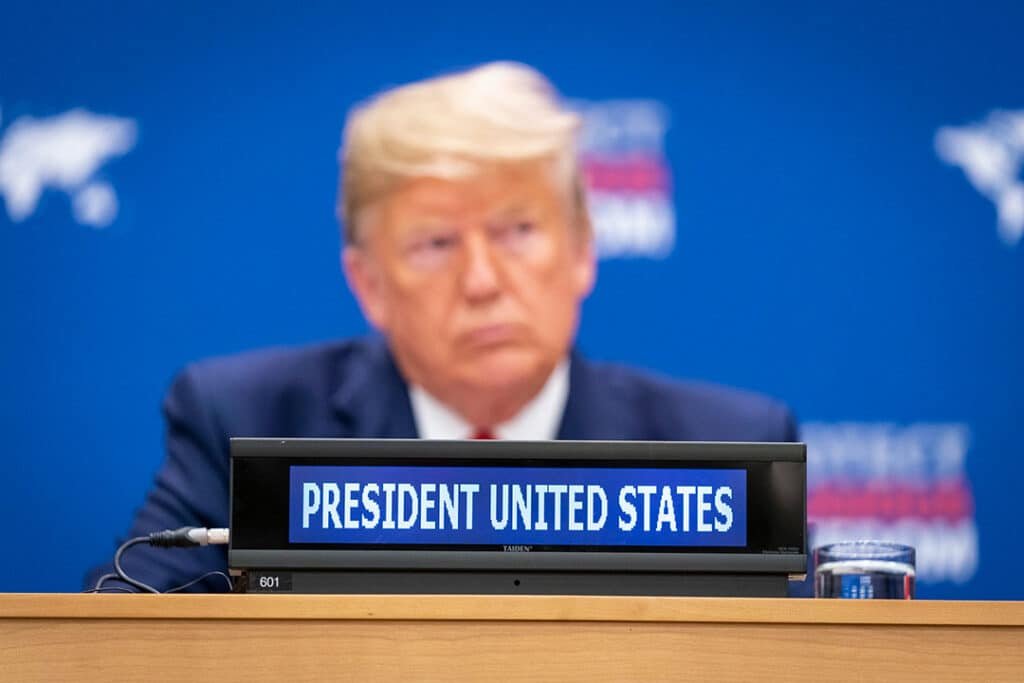Photo by Shealah Craighead/White House
The Trump 2025 Israel–Iran Ceasefire has emerged as a crucial diplomatic move, signaling a shift in one of the most dangerous regional conflicts in recent years. On June 24, 2025, former U.S. President Donald Trump announced a ceasefire between Israel and Iran following nearly two weeks of escalating military conflict. While his re-entry into the international spotlight raised eyebrows, particularly due to the unconventional diplomacy he employed, the decision to push for a halt in hostilities deserves measured recognition. In a region long plagued by cycles of violence, proxy warfare, and mutual suspicion, this move—however temporary—has created space for de-escalation, humanitarian relief, and potentially, long-term diplomatic engagement.
The conflict between Israel and Iran had rapidly spiraled out of control, triggered by a series of military exchanges and heightened rhetoric from both sides. Iran’s missile strikes on Israeli military installations were met with an aggressive Israeli response targeting key infrastructure in Iran, including facilities near nuclear development zones. Civilian areas were caught in the crossfire, leading to deaths, mass displacement, and heightened fears of a full-scale war that could engulf the entire Middle East. Amid this volatile environment, Trump’s 2025 ceasefire initiative served as a crucial intervention to break the cycle of violence.
Critics may argue that ceasefires are merely pauses between wars, lacking the substance of real peace. While that may be partially true, it is also worth noting that nearly every major peace agreement in modern history has begun with such pauses. They offer a chance to reset the narrative—from bloodshed to negotiation. In this case, the ceasefire did more than stop the bombs; it halted a dangerous trajectory that could have drawn in other regional powers, including Saudi Arabia, Iraq, Lebanon, and potentially global military alliances. A broader war could have destabilized not just the Middle East, but international markets, energy supplies, and diplomatic relations worldwide.
One of the immediate impacts of the ceasefire has been the reduction in civilian suffering. Both Iran and Israel suffered heavy losses, but civilians, as always, bore the brunt of the violence. Residential neighborhoods were bombed, essential infrastructure like hospitals and power stations were damaged, and entire communities were forced to flee. The ceasefire enabled aid organizations to re-enter conflict zones and begin relief operations. While this may be temporary, even a few days without aerial bombardments can mean the difference between life and death for thousands of civilians.
Another important dimension is how the ceasefire has revived diplomatic dialogue. In the lead-up to the conflict, international diplomatic mechanisms had largely failed, with both sides escalating their threats and military actions. By halting the violence, Trump’s move created room for backchannel communications, third-party mediation, and the resumption of multilateral talks. Even if the ceasefire is fragile, the act of agreeing to it signifies that both sides are open—at least tactically—to negotiation. That in itself is progress in an otherwise bleak diplomatic landscape.
Interestingly, Trump’s decision also sent a powerful message regarding the role of the United States in the Middle East. Traditionally, the U.S. has maintained unwavering support for Israel, often backing its military operations without question. By enforcing a ceasefire that applied pressure on both parties, Trump demonstrated a more balanced approach, showing that American influence could be used not just to defend allies, but to promote peace. This recalibration may help restore some credibility to the U.S. as a mediator, rather than a partisan actor.
Moreover, the ceasefire has helped calm global markets. Military conflict in the Middle East often sends shockwaves across the world, particularly due to the region’s central role in energy production and transport. The recent escalation had already caused fluctuations in oil prices and investor anxiety. With the ceasefire in place, markets responded positively, demonstrating how peace in one region can have a stabilizing effect on the global economy. This is an often overlooked but vital aspect of conflict resolution—its ability to bring economic reassurance far beyond the battlefield.
The strategic value of the ceasefire extends to the internal politics of both Israel and Iran. Prolonged conflict places enormous pressure on national budgets, divides public opinion, and weakens governments already facing social and economic challenges. By pausing the war effort, both governments have been granted space to regroup, assess public sentiment, and potentially engage in more sustainable decision-making. It also offers both leaderships a way to save face—retreating from direct conflict without appearing to surrender.
Another benefit of the ceasefire is its effect on the broader regional order. It opens the door for other Middle Eastern nations to step into a mediating role, particularly those that have ties to both Iran and Israel. Countries like Qatar, the UAE, and Turkey could now serve as facilitators in broader peace discussions, moving away from mere spectatorship toward active engagement in shaping the region’s future. This distributed diplomacy is crucial for long-term stability, as peace must be owned and maintained by the region itself.
Additionally, a ceasefire undermines the narratives used by extremist groups to recruit and radicalize. When war dominates headlines, it feeds cycles of anger and desperation that these groups exploit. A pause in violence shifts the narrative and gives moderates a stronger platform to speak and act. It is difficult to quantify how many radicalization attempts are thwarted by peace, but history suggests that reduced conflict correlates with reduced recruitment to violent causes.
The decision also gives negotiators a unique opportunity to return to issues long ignored: Iran’s nuclear ambitions, Israel’s regional security concerns, and the role of militias and proxies across the Middle East. These are not problems that can be solved overnight, and perhaps not even within a single ceasefire agreement. But with the immediate threat of all-out war paused, there is room to address these fundamental challenges with greater seriousness and fewer distractions.
In conclusion, Donald Trump’s decision to push for a ceasefire in the 2025 Israel–Iran conflict may not end the hostility permanently, but it is undoubtedly a step in the right direction. It halts violence, saves lives, revives diplomacy, stabilizes markets, and creates an opening for broader political and strategic engagement. In a region too often caught in a vicious cycle of retaliation, even a temporary halt can be the beginning of something larger. Whether that potential is realized depends on the next steps taken—not just by Trump or the U.S., but by regional powers, international institutions, and the people most affected by the decisions made in war rooms far from their homes.


